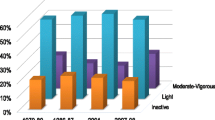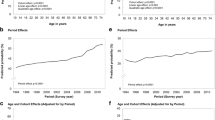Abstract
Marked age-dependent physical inactivity is generally assumed in the health science literature. On the basis of cross-sectional studies it is assumed that the probable physical inactivity increases linearly with increasing age. Health economical analyses based on this assumption result automatically in the conclusion that an aging society and the associated increasing inactivity will lead to higher health-care costs. The object of this paper was to check the validity of this underlying assumption. The data records of the German Socio-Economic Panel Study (GSOEP) for the years 1985–2001 served as a basis. With the aid of longitudinal and cohort sequence analyses, it was shown that not only the effects of age, but also those of period and cohort effects always influence health behaviour. The effects of age can be absolutely compensated for, or in part even overcompensated, by the period and cohort effects. For this reason, the aging of society itself does not necessarily lead to higher health-care costs owing to certain parameters of health behaviour, even if cross-sectional studies show an increasing incidence with age.

Similar content being viewed by others
Notes
Period effects are effects of social change that influence all age and cohort groups at a certain point of time. In contrast, cohort effects are effects of social change that influence only certain cohorts at a certain point of time.
Specifically, it was asked, how often the persons questioned participated in active sports. It was assumed that this would be a valid indicator for physical activity and/or inactivity. As a criterion for inactivity, the category of less than once per week was chosen.
Strictly speaking, the equalisation of sports and physical activity as well as sports and physical inactivity is not without problems. For example, the perceptions of sports activity could have changed more expeditiously than those of physical activity. However, it is assumed that the methodological shortcoming of that is less important than the methodological shortcoming of cross-sectional studies.
To avoid methodological snares, the survey years 1984, 1990, 1995 and 1998 were additionally excluded from the analyses. In the years 1990, 1995 and 1998, the frequency of physical activity and/or inactivity surveyed used a scale of five instead of—as in most surveys—a scale of four. In 1984, a scale of three was used.
One could argue that modification of the population structure following the German unification could have exercised a marked influence on the inactivity rates. In fact, this is correct. The inactivity rates for East and West Germans are significantly different. Actually, the inactivity rates for East Germans are higher than those for West Germans, so that the unification has had a weakening effect on the reduction of the inactivity rates.
A single variance analysis was carried out with physical inactivity as a dependent 0/1-dummy variable and with the measuring point in time 1985 and 2001, respectively, as independent variable.
That all solution models only explain a negligible part of the total variance is not a problem. The object of the analysis was not to test a theoretical model as complete as possible, particularly as this would have required more than just proxy variables [e.g. the comprehensive list of determinants for sports and/or physical activity drawn up by Sallis and Owen (1999)].
It is certainly valid for the sex-specific findings that interferences between the cohort and period effects are to be presumed as well because of the above-mentioned reasons.
References
Baltes PB (1968) Longitudinal and cross-sectional sequences in the study of age and generation effects. Hum Dev 11:145–171
Blair SN (1996). Physical activity, physical fitness, and health. The Club of Cologne (ed) Health promotion and physical activity. Strauss, Cologne, pp 11–36
Gratton C, Taylor P (2000) Economics of sport and recreation. Spon, London
Huinink J (1988) Methoden der explorativen Kohortenanalyse. Z Bevölkerungswissenschaft 14:69–87
Mendelson DN, Schwartz WB (1993) The effects of aging and population growth on health care costs. Health Affairs 1:119–125
Rice DP, Fineman, N (2004) Economic implications of increased longevity in the United States. Annu Rev Public Health 25:457–473
Sallis JF, Owen N (1999) Physical activity & behavioural medicine. Sage, Thousands Oaks
Schaie KW (1965) A general model for the study of developmental problems. Psychol Bull 64:92–107
Shephard RJ (1990) Costs and benefits of an exercising versus a nonexercising society. In: Bouchard C, Shephard RJ, Stephens T, McPherson B (eds) Exercise, fitness and health. Human Kinetics, Champaign, pp 49–60
Shephard RJ (1997) Aging, physical activity and health. Human Kinetics, Champaign
Smala A, Beeler I, Szucs TD (2001) Die Kosten der körperlichen Inaktivität in der Schweiz. MERG, Munich
US Department of Health and Human Services (1996) Physical activity and health. A report from the Surgeon General. Atlanta
Weiss O (2001) Sport und Gesundheit. Eine sozio-ökonomische Analyse. BMSG, Vienna
Willekens FJ (1992) National population forecasting: State-of-the-Art and research needs. In: Keilmann N, Cruijsen H (eds) National population forecasting in industrialized countries. Swets & Zeitlinger, Amsterdam, pp 283–322
Author information
Authors and Affiliations
Corresponding author
Rights and permissions
About this article
Cite this article
Breuer, C. Cohort effects in physical inactivity. J Public Health 13, 189–195 (2005). https://doi.org/10.1007/s10389-005-0110-5
Received:
Accepted:
Published:
Issue Date:
DOI: https://doi.org/10.1007/s10389-005-0110-5




